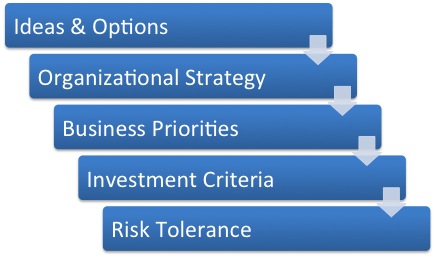I travel frequently, and often find myself in situations that demand quick thinking. It was nearly a month ago when, upon arrival at the O’Hare Airport in Chicago, I learned that my departing flight had been cancelled. As a frequent flier, I recognized that I had three options. Call my travel agent and let them determine my options, await the airline to provide options to me or respond quickly by finding the nearest customer service agent to discuss my dilemma. You can guess which option I took. Within 15 minutes, I had spoken with an agent and found a new flight that would still have me arrive at LaGuardia well before my connecting flight.
Success at achieving goals comes from one’s ability to make decisions quickly and effectively, identifying options and ideas, and then assessing them against our objectives. The same can be said for achieving success in business. Improving both the velocity and value of decision-making is one of the most effective means of improving organizational performance, the process of which is built upon lean principles.
During a recent client engagement, I spent some time with a group of senior leaders reviewing their decision-making process in an effort to lean out the process, resulting in faster, more-effective decisions with greater value to their customers, employees and shareholders. We began by identifying the most significant obstacles that were limiting their ability to achieve rapid and effective decisions, the majority of which could be captured in the following categories:
- Multiple priorities
- Misaligned objectives
- Competing interests
- Limited available resources
We then applied lean thinking to identify the most significant opportunities to improve their decision-making model and maximize it’s effectiveness. The three key elements were the following:
Defining Value
The starting point in a decision-making model is to determine what constitutes a valuable decision. The factors that determine value in decisions and their priority can differ for each and every organization. For example, a valuable decision matrix for an automotive manufacturer would likely consist of the following order of factors:
- Optimize production
- Provide acceptable quality
- Ensure employee safety
Now consider the elements of a valuable decision matrix for a power generation company, which would differ slightly. For example:
- Ensure employee safety
- Maximize output
- Reduce downtime
The first step in creating an effective decision-making model is to determine what constitutes value in decisions and their level of importance for the organization. Value acts as guiding principles upon which decisions can be made and measured.
Critical Components
With value identified, the next step is to define what are the critical components to an effective decision. Most decisions begin with a variety of ideas and options. The rationale for the idea or option determines whether there will be further consideration. Next, the ideas or options pass through a series of filters, ultimately ending with a decision or series of decisions that are deemed to be both well thought out and effective.
Figure 1 below demonstrates the critical filters that a decision must pass through in order to reach an effective decision.
 |
| Figure 1. |
Increasing Decision-Making Velocity
Once decisions are deemed valuable and decision filters have been defined, the next step is to increase the speed with which decisions are made. Increased velocity in the decision-making process results from making incremental improvements in how ideas or options are escalated, reviewed and decided upon. Lets consider for a moment a brief case study from a past client of mine. The company was slow to make decisions around improvements in production equipment, causing delays and poor morale between production and finance. In the old model, new ideas for equipment or upgrades were brought from the production floor to production management, who in turn would discuss with the company president. Once the president approved the investment, the acquisition was escalated to a finance manager who in turn would challenge the expenditure. The result was bad blood between the two departments and unnecessary delays in equipment acquisition or upgrades. All three parties in this example believed they were doing the right thing. We reviewed the decision-making model following the steps above and to increase decision-making velocity, we initiated a monthly meeting between the VP of production, the VP of finance and the president, during which productivity improvements requiring investment were presented, assessed, discussed and then decided upon. This ultimately increased the velocity with which decisions were made, and increased the alignment of the senior management team.
Now I know this example might sound too simple, but that’s the point. If applied correctly, lean should make the complex simple, not vice versa. So the next time you are considering how to improve your organizational effectiveness, consider how lean can be applied to the decision-making process to increase both velocity and value. Your employees, customers and shareholders will thank you for it!
Shawn Casemore is the founder and president of Casemore and Co. Incorporated, a consulting company helping organizations improve their operational performance. A recognized speaker and writer, you can learn more about Shawn and his company by visiting casemoreandco.com. © Shawn Casemore 2013. All rights reserved.


